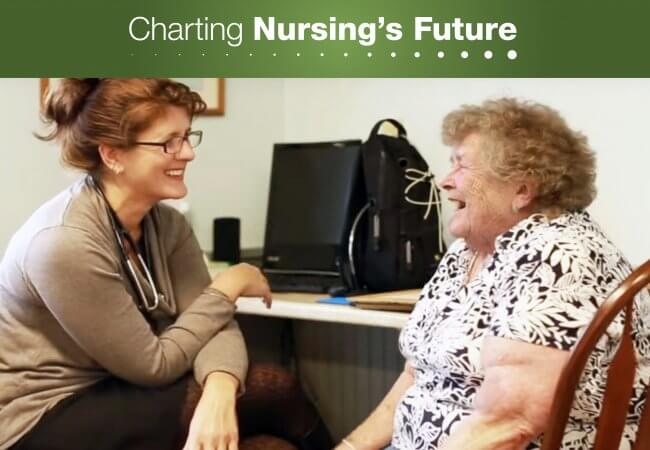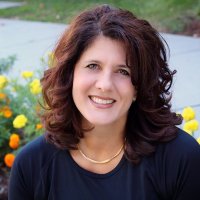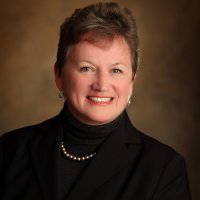
Nov 06, 2019
Nurses Central to Combining Health Care with Housing

Kristi Poehlmann, BSN, RN, consults with SASH participant, Marie Salter, about her lung health. Regular check-ins with Kristi have helped Marie avoid hospitalization for pneumonia. Photo: Shem Roose Imagery
No one should have to give up their independence just because they are incontinent or need help managing their medications. That’s what Nancy Eldridge, MA, former executive director of Vermont’s Cathedral Square Corporation, thought when she noticed residents moving prematurely from her organization’s subsidized housing facilities into nursing homes. She knew what she wanted to do. “Integrating health and housing had been a long-time passion of mine,” Eldridge says. “The situation concerned me ethically, but also, I wondered what we were paying to put people in an institution when it was avoidable.”
The Idea
In 2011, Eldridge turned her passion for combining health care and housing into Support and Services at Home, or SASH. The program provides older adults and people with disabilities who live in and around Vermont’s subsidized housing complexes with an onsite health team. Each team consists of a wellness nurse and a care coordinator who serve approximately 100 participants at one site or across multiple locations.
The objective, explains Eldridge, is to improve overall wellness and keep residents living in their homes longer. To this end, SASH uses evidence-based practices to provide:
- transitional care, which manages an individual’s movement to and from the hospital;
- coordination of care, which improves communication among the residents and their providers; and
- improved self-management of chronic conditions.
“The beauty of it,” says Eldridge, “is that the infrastructure was already there—and paid for. When we mapped existing subsidized housing in the state, we found it was like a highway, ranging from rural mobile home parks to urban apartment complexes.” With current funding, SASH serves 5,000 older adults at 140 of these housing communities in the state.
The Care

Kristi Poehlmann, RN, says working for SASH was “one of the best jobs I have ever had.” She left SASH in January 2019 to finish her master’s degree and become an advanced practice registered nurse in adult gerontology. She is also working on her doctoral degree and hopes to see SASH come to Connecticut, where she resides.
Kristi Poehlmann, BSN, worked as a wellness nurse for SASH from 2011 til until earlier this year and says it “was one of the best jobs I have ever had as an RN. You are alone in the field working at the highest level of your license, assessing patients, working on chronic disease management, providing transitional care, and coordinating care. Everything you’ve learned.”
Poehlmann explains that those who opt into SASH meet with the care coordinator then talk with the nurse about their personal health goals and concerns. The nurse also screens for depression, anxiety, loneliness, and nutrition risk. “We’re not prescribing our ideas,” says Poehlmann, who stresses her role as a health coach for chronic conditions such as hypertension or diabetes. “We want participants to drive their own health with our guidance and knowledge.”
Eldridge says the nurses are crucial to the program’s success because they can perform assessments and coordinate with the resident’s primary care provider. Poehlmann adds, “As one of the most trusted professions in the country, we know how to build rapport and relationships, so participants know we’re going to help them, that they’re not alone.”
Poehlmann describes a relationship she developed with one participant with chronic obstructive pulmonary disease (COPD). Through their rapport, the participant learned that regular check-ins with Poehlmann could help her monitor symptoms well enough to avoid hospitalization or visits to the emergency room.
The most significant service SASH provides, according to Eldridge and Poehlmann, is medication reconciliation in the home. SASH nurses collect medication type and dose information and enter it into a centralized database. In one instance, Poehlmann says, “we had a patient come home from the hospital after having pneumonia, and when the nurse went through her medications, she found no antibiotic.” She was able to update the record and rectify the situation with the participant’s health care provider.
The Results
In addition to anecdotal evidence showing SASH diverts emergency room visits and nursing home admissions, hard data also show the program works. A study funded by the U.S. Department of Housing and Urban Development (HUD) and the U.S. Department of Health and Human Services shows slower annual growth in Medicare expenditures by $1,450 per urban SASH participant compared to a control group. The study shows no reduction in Medicare costs in rural areas, which Eldridge attributes, in part, to lower population density. The key to making the program sustainable for states, she explains, “is to get the right mix so the urban savings can carry the rural [implementation].” She also emphasizes that for dually eligible participants across the state, Vermont slowed growth in Medicaid expenditures by an average of $400 per SASH participant by keeping them out of nursing homes.

Nancy Eldridge, CEO, National Well Home Network, founded SASH when she was executive director of the Cathedral Square Corporation in Vermont. She is currently implementing SASH in Rhode Island and Minnesota.
SASH’s success has had a national impact. The program inspired a 2017 $15 million HUD pilot designed to test a similar model called Integrated Wellness in Supportive Housing, or IWISH. IWISH, which is now underway in 40 housing communities in seven additional states, has the same core components, assessments, and person-centered approach as SASH, but differs because, “They don’t have scale,” says Eldridge. “They don’t yet serve individuals in the surrounding community.”
This matters to Eldridge, who thinks big. As current CEO of the National Well Home Network, she has expanded implementation of SASH with pilots in Rhode Island and Minnesota. By creating a statewide system, she hopes to generate the information needed to someday go national. “We need a health team serving every subsidized housing community and its surrounding neighborhoods,” says Eldridge. “We need to be there because behavior begins at home—not in the doctor’s office.”
